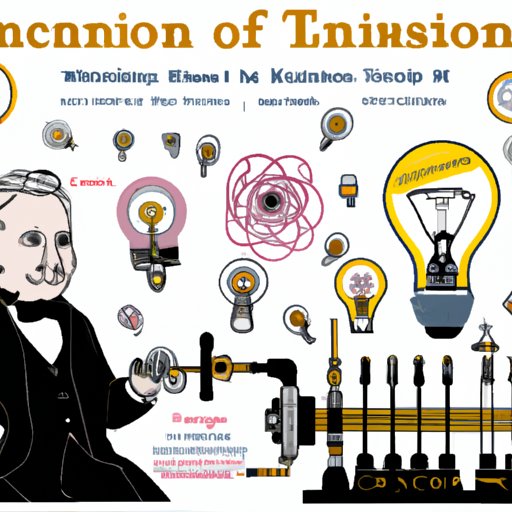Introduction
Thomas Edison was one of the most influential inventors of all time. He is credited with creating or improving many of the technologies we use today, from the light bulb to the phonograph. In this article, we’ll explore Edison’s life and accomplishments and look at what he invented and developed.
Exploring Thomas Edison’s Life and Achievements: A Look at What He Invented
Edison was born in 1847 in Milan, Ohio. He was a voracious reader as a child, but he had little formal education due to a learning disability. He taught himself science, engineering, and business skills, and he began experimenting with electricity by the age of 12. By the time he turned 21, he had already established himself as an inventor.
Edison was responsible for several breakthrough inventions throughout his lifetime. He created the world’s first commercial light bulb in 1879, which revolutionized indoor lighting. He also invented the phonograph in 1877, which was the first device capable of recording sound. His other notable inventions include the motion picture camera, the alkaline storage battery, and the electric power generator.
An Overview of Thomas Edison’s Patents: Examining His Greatest Inventions
Throughout his career, Edison was granted more than 1,000 patents for his inventions. Here are some of the most notable ones:
Light Bulb – Edison’s most famous invention was the light bulb. He spent years developing the technology and perfecting the design, and in 1879 he unveiled the world’s first commercially viable incandescent lamp. This invention has since changed the way we light our homes and businesses.
Phonograph – Edison’s invention of the phonograph in 1877 was revolutionary. It was the first device capable of recording and reproducing sound, and it laid the foundation for modern audio recording technology.
Motion Pictures – Edison was also involved in the development of motion pictures. He patented the Kinetoscope, a peephole viewing machine, in 1893. This invention was later used as the basis for the modern movie projector.
Electric Power Generation – Edison also developed several methods for generating electric power. He patented the steam-powered generator in 1889, and he also developed systems for transmitting electricity over long distances.
Telegraphy and Telephony – Edison was also involved in the development of telegraphy and telephony. He developed the quadruplex telegraph in 1874, which allowed multiple messages to be sent simultaneously over a single wire. He also patented the carbon microphone in 1876, which improved the clarity of telephone transmissions.
The Impact of Thomas Edison’s Inventions: What They Changed in Society
Edison’s inventions have had a profound impact on society. Here are some of the ways his inventions have changed our lives:
Improved Quality of Life – Edison’s inventions have made life easier and more comfortable. The light bulb brought light into our homes, while the phonograph and motion pictures provided entertainment. The electric power generator enabled us to power our homes and businesses, and the telegraph and telephone allowed us to communicate quickly over long distances.
Increased Productivity – Edison’s inventions also increased productivity. The electric power generator made it possible to run factories and machines with greater efficiency. The phonograph and motion pictures allowed people to share information, ideas, and culture more quickly. The telegraph and telephone allowed people to communicate and collaborate more effectively.
Greater Access to Information – Edison’s inventions also gave people greater access to information. The phonograph and motion pictures allowed people to learn about different cultures and events. The electric power generator enabled people to use electricity to power their homes and businesses. The telegraph and telephone allowed people to send and receive information quickly over long distances.
How Thomas Edison Revolutionized Technology: What He Invented and Developed
Edison’s inventions and developments revolutionized technology and paved the way for modern advancements. Here are some of the ways he changed the world:
Incandescent Lighting – Edison’s invention of the light bulb revolutionized indoor lighting. He developed a durable, efficient incandescent lamp that could be powered by electricity. This invention made it possible to light up homes and businesses without using candles or gas lamps.
Automated Manufacturing – Edison also developed automated manufacturing processes. He developed assembly line techniques and introduced standardized parts, which made it easier and faster to produce goods. He also designed machines that could do the work of many people, which increased productivity and lowered costs.
Audio Recording and Reproduction – Edison’s invention of the phonograph revolutionized audio recording and reproduction. This invention allowed people to record and reproduce sound for the first time. It also paved the way for modern audio recording technology, such as digital audio editing.
A Timeline of Thomas Edison’s Inventions: From the Light Bulb to the Phonograph
Here is a timeline of some of Edison’s most notable inventions:
1877 – Light Bulb – Edison unveiled the world’s first commercially viable incandescent lamp.
1878 – Phonograph – Edison patented the phonograph, the first device capable of recording and reproducing sound.
1889 – Electric Power Generation – Edison patented the steam-powered generator, a major step forward in electric power generation.
1893 – Motion Pictures – Edison patented the Kinetoscope, a peephole viewing machine that was the basis for the modern movie projector.
Conclusion
Thomas Edison was one of the most influential inventors in history. He invented or improved many of the technologies we use today, from the light bulb to the phonograph. His inventions revolutionized technology and changed the way we live. His legacy will continue to inspire future generations of innovators.
(Note: Is this article not meeting your expectations? Do you have knowledge or insights to share? Unlock new opportunities and expand your reach by joining our authors team. Click Registration to join us and share your expertise with our readers.)
